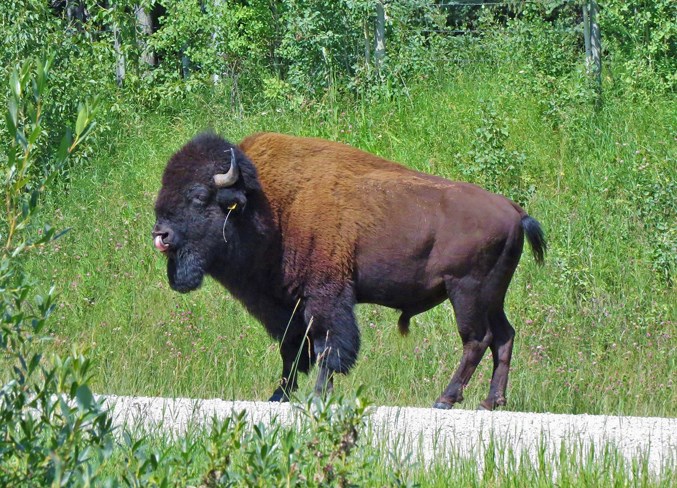A wayward bison from a herd that was reintroduced in Banff National Park as part of a pilot project has a new home after being discovered wandering around Sundre’s backyard.
The bull was sighted making its way east and subsequently ended up northwest of Sundre. Parks Canada received the first report on Thursday, Aug. 1, when the animal was spotted in a remote region outside of Banff National Park and outside the Provincial Upper Red Deer Special Bison Area, reads information sent to the Round Up by Justin Brisbane, a spokesperson with the Parks Canada Agency’s Banff Field Unit.
“On August 2 and 3, Parks Canada Resource Conservation staff acted immediately to investigate the report using aerial searches, ground patrols, and remote cameras,” his statement reads.
The bison was located on Sunday, Aug. 4 roughly 15 kilometres northwest of town following another public tip and an extensive search. From the time of the first reported sighting on Aug. 1, the bull had travelled about 44 kilometres east.
“Given the proximity of this bison to agricultural areas and the continued eastward movement towards surrounding communities, Parks Canada made the decision to immobilize and relocate the bison to Rocky Mountain House National Historic Site.”
Courtesy of the public’s reports, Saundi Stevens, a resource management officer with Banff National Park, told the Round Up during a phone interview on Wednesday, Aug. 14 that a crew was able to find the bull making its way along back roads.
“They were up early in the morning, checking out the area. Sure enough it was walking along the road,” she said, adding the animal had been tagged with a very high frequency (VHF) transmitter.
“They were quickly able to confirm that it was indeed one of our Banff bison bulls.”
Using a dart gun, she said conservation officers tranquilized the animal, which subsequently moved off the road as the drugs quickly took effect.
“It induced fairly rapidly,” she said.
Luckily, the team was able to back a truck and trailer right up to the bison, facilitating the effort to load the animal, she said.
”The crew set up a 3:1 pulley system from the front of the horse trailer to pull him up a ramp into the trailer. One person was able to manage, or hold up, the bison’s head while the others worked the pulley,” she said, adding the ”animal slid in smoothly.”
The crew then promptly proceeded to reverse the tranquilizer, waking up the bull to monitor its condition during transportation to Rocky Mountain House since health complications can arise from leaving an immobilized animal on its side, she said.
The bison, which is safe and healthy, joined the small herd of plains bison that Parks Canada manages at Rocky Mountain House National Historic Site, said Brisbane’s statement.
Since the reintroduction zone is not completely fenced, bison “excursions” from that area into other parts of the national park and even farther onto provincial lands — while uncommon — are nevertheless possible, it said.
In 2017, the herd was brought out from Elk Island National Park, located just east of Edmonton, and introduced to a soft-release pasture in a corner of Banff’s backcountry about 30 kilometres from the Town of Banff, said Stevens.
The soft-release pasture, she explained, was a fenced holding area in the centre of the overall reintroduction zone. The idea was to temporarily hold them there through a couple of calving cycles to help the animals “anchor” to the area as their new home.
Then, in the summer of 2018, she said the gates were opened, allowing the 35 bison to roam freely around the approximately 1,200-square-kilometre reintroduction zone.
“Since then, the herd has been thriving in its new habitat,” said the press statement, citing the project’s objective as an attempt “to explore the long-term feasibility of restoring North America’s largest land mammal to Canada’s first national park.”
The goal, said Stevens, is now to continue monitoring and managing the herd’s reintroduction until the pilot project’s conclusion in 2022, “at which point we’ll complete a review of all the activities to date and decide whether it’s feasible for the long term.”
That process, she added, will include but not be limited to completing a detailed environmental impact assessment that will also involve measuring the herd’s health and movements.
“Various visitor experiences will also be taken into consideration.”
Although infrequent, encounters can and clearly do occur. While only one bison left the zone this year, two animals ventured away last year. One was put down, while the other was captured and relocated to Waterton Lakes National Park’s bison paddock, according to press reports.
Officials encourage any members of the public who spot a bison on provincial lands to promptly contact the Banff National Park dispatch at 403-762-1470 and report the sighting, she said.
Sometimes, domesticated bison also escape their enclosures. But she added crews are able to ascertain an animal’s origin and determine whether it belongs with the herd in Banff.
People are also urged to follow safe practices in the event of an encounter.
“Remain calm and do not approach. Give them lots of space,” she said, recommending maintaining a minimum distance of at least 100 metres.
Although not typically overly territorial and even generally docile around and tolerant of park staff as well as the public, she said cows can during calving season in the spring be aggressively protective of their young.
Despite the few incidents over the past couple of years, the vast majority of the Banff bison herd has remained within the area. At least two new calves were born in 2019, bringing the current herd total to at least 35 animals, said the press release.
Visit parkscanada.gc.ca/banff-bison for more information about the Banff Bison reintroduction project.



